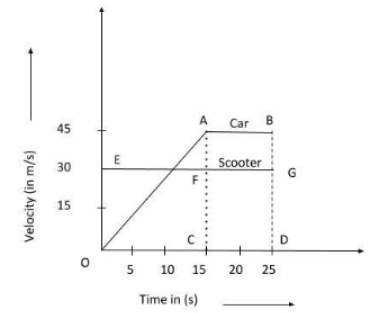The speed of a car as a function of time is shown in figure.

Find the distance travelled by the car in 8 seconds and its acceleration.
The correct Answer is:B
In the inerval 8 sec the velocity changes from 0m/s to 20 m/s. Average accelerationn =208ms2<br>=2.5ms2(chan≥∈velocitytime)<br><imga≤ocr_imageload∈g=lazysrc=https://d10lpgp6xz60nq.cloudfront.net/physics_images/HCV_VOL1_C03_E01_043_S01.pngwh=80%mx-autosty≤=background:white;><br>Distancetravel≤d,<br>S=ut+ 1/2 at^2
=0+1/2 (2.5)8^2=80m
Topper's Solved these Questions
- REST AND MOTION : KINEMATICSBook:HC VERMA ENGLISHChapter:REST AND MOTION : KINEMATICSExercise:Question for short Answer
Explore 13 Videos
- REST AND MOTION : KINEMATICSBook:HC VERMA ENGLISHChapter:REST AND MOTION : KINEMATICSExercise:Objective -2
Explore 9 Videos
- PHYSICS AND MATHEMATICSBook:HC VERMA ENGLISHChapter:PHYSICS AND MATHEMATICSExercise:Question for short Answer
Explore 14 Videos
- ROTATIONAL MECHANICSBook:HC VERMA ENGLISHChapter:ROTATIONAL MECHANICSExercise:Questions for short Answer
Explore 21 Videos
Similar Questions
The velocity of a car as a function of time is shown in Fig. Find the distance travelled by the car in 8s and its acceleration.

View SolutionSpeed time graph of a particle shown in figure. Find distance travelled by particle in 5second.

View SolutionThe acceleration of a cart started at t=0 varies with time as shown in figure. Find the distance travelled in 30 seconds and draw the position time graph.

View SolutionThe velocity-time graphsof a car and a scooter are shown in the figure. (i) The difference between the distance travelled by the car and the scooter in 15 and (ii) the time at which the car will catch up with the scooter are, respectively.

View SolutionThe velocity-time graphs of a car and a scooter are shown in the figure. (i) The difference between the distance travelled by the car and the scooter in 15 s and (ii) the time at which the car will catch up with the scooter are, respectively.

View SolutionFrom the velocity time plot shown in figure find the distance travelled by the particle dureing the first 40 seconds. Also find the average velocity during this period.

View SolutionThe speed of a car increases uniformly from zero to 10ms−1 in 2s and then remains constant (figure)

a. Find the distance travelled by the car in the first two seconds.
b. Find the distance travelled by the car in the next two seconds.
c. Find the total distance travelled in 4s.
View SolutionA car travels for 20 min with a constant speed of 54 km h−1 Find the distance travelled by the car.
View SolutionA car is moving with speed u. Driver of car sees a traffic light. His reaction time is t, then find out the distance travelled by the car after the instant driver decided to apply breaks?
(Assume uniform retardation “a” after applying breaks.)
View SolutionA car initially travelling eastwards turns noth by travelling in a quarter circular path of radius R metres at uniform speed as shown in figure. The car completes the turn in T second.
(a) What is the acceleration of the car when it is at B located at an angle of 37∘. Express your a swers in terms of unit vectors ˆi and ˆj.
(b) The magnitude of car's average acceleration during T second period.

View Solution
